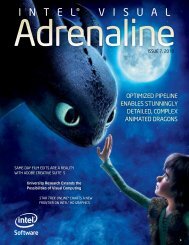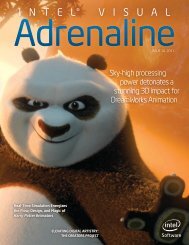Intel HD Graphics DirectX Developer's Guide (Sandy Bridge)
Intel HD Graphics DirectX Developer's Guide (Sandy Bridge)
Intel HD Graphics DirectX Developer's Guide (Sandy Bridge)
Create successful ePaper yourself
Turn your PDF publications into a flip-book with our unique Google optimized e-Paper software.
<strong>Intel</strong>® <strong>HD</strong> <strong>Graphics</strong> <strong>DirectX</strong>* <strong>Developer's</strong> <strong>Guide</strong><br />
b. Balance a Z-only pass against the inherent cost of an additional pass – do not<br />
do this at the cost of including more render state changes or worse batching<br />
due to sorting.<br />
c. Avoid using modified Z values (depth) in the pixel shader. Modifying the<br />
depth value will skip the Early-Z hardware optimization algorithm since it<br />
potentially changes the visibility of the fragment.<br />
7. Use the Occlusion Query feature of Microsoft <strong>DirectX</strong>* to reduce overdraws for<br />
complex scenes. Render the bounding box or a simplified model – if it returns<br />
zero, then the object does not need to be rendered at all.<br />
a. Allow sufficient time between Occlusion Query tests and verifying the results<br />
to avoid serializing the platform. See the Microsoft <strong>DirectX</strong>* 10 “Draw<br />
Predicated” sample included in the Microsoft <strong>DirectX</strong>* SDK for more<br />
information on this.<br />
See Section 3.10.7 Avoid tight polling on queries for more tips on using<br />
queries properly.<br />
8. Consider drawing the opaque overlays in the scene such as heads up displays<br />
(HUD) first and writing them to the Z buffer. This reduces the screen rendering<br />
area leading to considerable performance improvement.<br />
3.2 Shader Capabilities<br />
<strong>Intel</strong>® <strong>HD</strong> <strong>Graphics</strong> includes support for Microsoft <strong>DirectX</strong>* Shader Model 4.1 for 10.1<br />
devices and Shader Model 3.0 for <strong>DirectX</strong>* 9 devices. <strong>Intel</strong>® microarchitecture code<br />
name <strong>Sandy</strong> <strong>Bridge</strong> provides significantly improved computational capability and<br />
better handling of large and complicated shaders over prior architectures.<br />
In addition to Microsoft <strong>DirectX</strong>* 10.1 hardware support, <strong>Intel</strong>® <strong>HD</strong> <strong>Graphics</strong> includes<br />
partial Microsoft <strong>DirectX</strong>* 11 API support. As such, many extended D3D11_Feature<br />
options such as multithreading, CS4.x support, are supported. Utilize the <strong>DirectX</strong>*<br />
call CheckFormatSupport() for individual format support of the<br />
D3D11_FORMAT_SUPPORT enumeration.<br />
3.2.1 Tips on Shader Capabilities<br />
1. Utilize the highest possible shader model for the required <strong>DirectX</strong>* device - for<br />
example, choose SM 3.0 over earlier versions for <strong>DirectX</strong>* 9.<br />
a. <strong>Intel</strong>® <strong>HD</strong> <strong>Graphics</strong> contains improved hardware efficiency for shorter<br />
shaders which were typically found in SM 1.X.<br />
2. Use programmable shaders over fixed functions as much as possible.<br />
a. In particular, use shader-based fog instead of fixed function fog on <strong>DirectX</strong>*<br />
9. Fixed Function fog has been deprecated on SM 3.0.<br />
16 Document Number: 321371-002US













